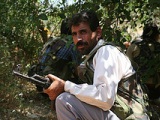The Case for Rebel Victory?
8 Feb 2013
In the Spring 2010 issue of International Security, Monica Duffy Toft presented a thesis that seemed counterintuitive to others. If you want to establish a genuinely long-lasting peace, external pageshe suggestedcall_made, civil wars should be allowed to play themselves out — i.e., one side should be permitted to prevail over the other. Indeed, trying to secure a peace accord prior to such a conclusion is not only ill-advised, it is also inadvertently cruel. This assertion, of course, demanded proof, which Toft readily provided. If you methodically dissect the 118 civil wars that have occurred between 1940 and 2002, she observed, the statistics speak for themselves. In those conflicts where one side did defeat the other, the likelihood of rekindled violence went down by 24 percent. In contrast, potentially premature peace accords and settlements increased the odds of revived bloodshed by 27 percent. Moreover, in yet another counterintuitive twist, Toft’s analysis confirmed that the statistical relationship between victory and war termination mostly depended on rebel victories rather than government ones.
To be fair to her sample and conclusions, Toft does carefully distinguish civil wars from other types of intra-state conflict, such as 1) small-scale or low-intensity insurgencies which involved fewer than 1,000 casualties per year, 2) conflicts in which control over the “central political apparatus” was not at stake, 3) enormously one-sided conflicts which could best be described as massacres or genocides, and 4) conflicts between different sets of non-state actors. Finally, Toft’s analysis also covers only completed civil wars, which she defined as those that as of 2007 had experienced “no violence for at least 5 years.”
Despite such methodological parsing, Toft’s findings remain striking. They fly in the face of those who have long concluded that stopping the bloodshed was, and always should be, everyone’s top priority in a civil war. Instead, the findings uncomfortably suggest that under the right circumstances, we need to give civil war a chance.
But why, one might ask? One obvious reason is that the winners of civil wars “are spared the costs of having to consider another actor's wishes," which then permits them to implement their post-war agendas more completely. Moreover, Toft argues that "rebel legitimacy and capacity may be endogenous to rebel victory." In other words, those who are the most capable of winning a civil war are probably the most able to build a stable post-war order.
To support the above conclusions, Toft uses the example of Uganda's Luwero or Bush War (1980-85). In the aftermath of that conflict, she argues, strong war-making institutions quickly became effective governing ones. The network of National Resistance Councils, which had been established to fight government forces, was quickly adapted to manage post-war political affairs, development projects, and elections. (For more on this subject, browse our Digital Library content on "Intra-State Conflict" and "Uganda".)
In the end, and as intriguing as Professor Toft’s historical analysis is, we are nevertheless left with an obvious question – What do her insights and conclusions mean for the world’s ongoing civil wars, and even its intrastate conflicts? To help our readers formulate their own answer to this question, we conclude this discussion by providing a selection of materials from our Digital Library on the following conflicts.
Burma, where local hostilities have been active since 1947. (Note: The generally understood start dates for the following conflicts are included in parentheses.)
The Sa’Dah Conflict in Yemen (2004)
The conflict in Northwest Pakistan (2004)
The insurgency in the Northern Caucasus (2009)
For a follow-on exchange on Toft’s methods and conclusions, see Laurie Nathan and Monica Duffy Toft, "Correspondence: Civil War Settlements and the Prospects for Peace," International Security, Vol. 36, No. 1 (Summer 2011), pp. 202-210.

